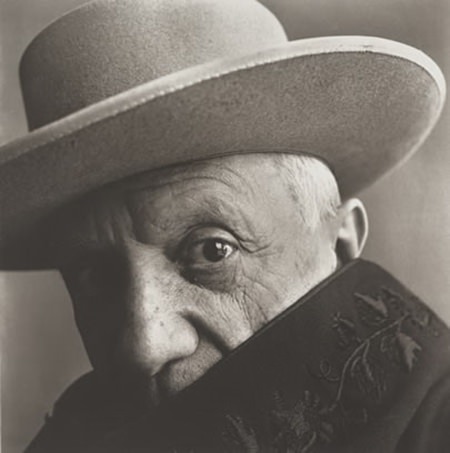If you ever see a secondhand book on photography – buy it! Sure it will have chapters on color photography as something ‘new’ and also home developing B&W pix in the bath tub, but there will also be some excellent advice on how to take better photographs.
I picked up “The Pictorial Cyclopedia of Photography”. Published in 1968, it was well before the digital revolution (though that should be “digital evolution” to be more correct). However, the major factor that came through to me was the predominant use of shadow. It was not a case of using bright colors in your photographs to make them stand out, it was a case of contrast by using black shadows. It made me think again about the true nature of photography.
 Picasso by Irving Penn.
Picasso by Irving Penn.
The true “definition” of photography has often been said as “painting with light” and quite honestly, this concept of painting with light is one of the more exciting aspects of photography. It is also something that even the weekend photographer can experiment with and produce photographs that will amaze not just you, but also those who view them, with their ability to leap off the paper.
The secret of painting with light is to remember that all photographs should have a mixture of light, and its opposite, called shadow. Blasting the subject with a sea of light produces flat, wishy-washy photographs. This is why I am not in favor of the in-camera flash that pumps out enough light power to illuminate the moon. To produce prints with depth requires shadow. Depth is the third dimension, and without it you only have a two dimensional flat image. For the impression of 3D, you need shadow.
Now getting back to the job of taking photographs and painting with a bit of light. The usual light source is the one I call the Great Celestial Light Technician. This is more commonly referred to as the sun. Now the sun will supply enough light to illuminate half the world at one sitting, so there’s plenty of power for your subject and then some.
However, that sunlight is not all that suitable for most of the day, because when the sun is directly overhead, you do not get nice shadows. In the early mornings or late afternoons, when the sun is closer to the horizon, the shadows are longer, more visible and give more depth. So as well as being a more flattering light in the golden glow afternoons, the sun is at a better angle to give good shadows. So to improve your daytime shots only shoot between sunrise and 9 a.m. and 4 p.m. till sunset.
Do not be afraid to let shadow into the shot. Position your subject so that they are not square on to the sun, but let the light come from about 45 degrees across the subject. Shadow adds mystery. Shadow adds that extra something.
However, you can provide the principal source of light, after the sun has disappeared. There are actually many sources of light after dark – there is the electronic flash, both the “on camera” type and the off camera type, there are tungsten studio lights, there are tungsten spotlights (like the garden varieties), there are street lights, neon lights and even car headlights. All these light sources are at your beck and call, and all (other than the on camera flash) can work for you to produce great shots. Just look at the shadows in the attached photo.
Many of you have a small flash unit that slips on to the “shoe” on the top of your camera. Do not use it there! Go and invest in a remote shoe. This comes with some electric cord that plugs into the camera body and has a shoe plate at the end of it that slips over the foot of your flash. You can buy extension cords too, and I would advise getting one about three meters long. Now you can position your subject anywhere you like and let the flash come down upon the subject at 45 degrees and you will get a much better photograph than the flash on top of camera straight on shot. Try it.




